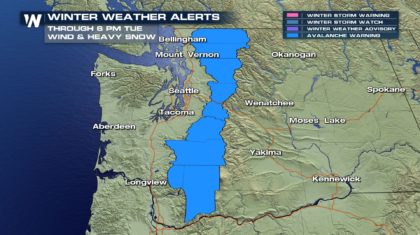What's Behind an Avalanche Warning?
Special Stories
23 Jan 2018 7:32 PM
Parts of the Cascade Mountains in Washington state were under avalanche warnings Tuesday as our latest winter storm moved into the Pacific Northwest.
The warnings were due to heavy snow and high wind.
https://twitter.com/NWSSeattle/status/955681415407923201
Avalanche
Simply put, an avalanche is a rapid flow of snow sliding down a slope.
Avalanches typically grow as they tear down slopes entraining more snow and at times trees, rocks, and other debris.
They can be triggered by anything from gravity, to wind, to humans or animals, or even a change in temperature– just to name a few.
The one constant between each of these events is that avalanches are never random, and no matter the type there are always precursors to a slide.
In each slide, initiation occurs when the load exceeds the strength of the snow.
The load is simply the weight of the snow, but the strength depends on everything from type of snow to the different layers of snow and even the steepness of the hill. And that just scratches the surface.
https://media.weathernationtv.com/news/avalanche-danger-unstable-snowpack/
Wind Load
The avalanche warnings for the Northwest were for heavy snow and high winds.
 This is known as a wind load. As strong winds blow new snow falling from the sky, it can do a few different things to cause an unstable snowpack.
This is known as a wind load. As strong winds blow new snow falling from the sky, it can do a few different things to cause an unstable snowpack.
 This is known as a wind load. As strong winds blow new snow falling from the sky, it can do a few different things to cause an unstable snowpack.
This is known as a wind load. As strong winds blow new snow falling from the sky, it can do a few different things to cause an unstable snowpack.
- Wind can cause snow to pile up in certain areas almost 10 times faster than it otherwise would just falling from the sky.
- As snow blows in the wind the flakes erode and change shape, making for a much more dense and therefore heavier snowpack.
- Strong wind can deposit snow on the leeside of a mountain, piling it up to the point of instability. Often in the form of a large cornice.
- Wind can also erode snow from the windward side of the mountain, eating away at the essential portion of the snowpack for stability.
All Weather News
More